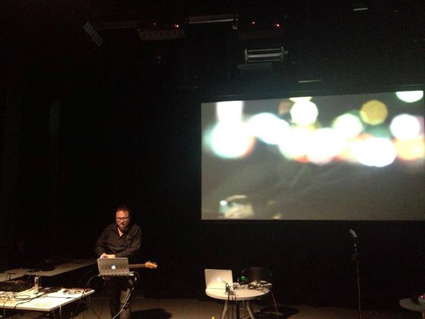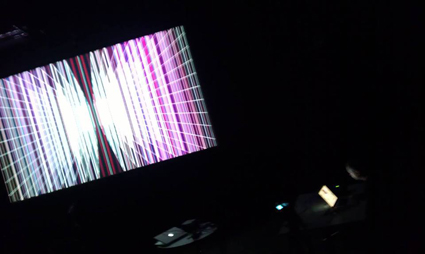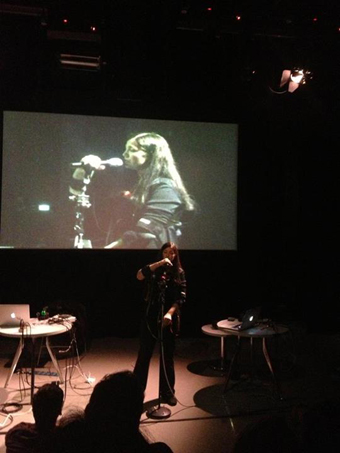New tools and old skool grammars
Gail Priest, Macrophonics II

Julian Knowles, Macrophonics II
photo Cat Hope
Julian Knowles, Macrophonics II
A common theme over the last seven days of ISEA2013 has been the relationship between old and new technologies. In his artist talk (part of the panel titled Nostalgia of the New, 9 June), musician/video artist Tom Ellard was emphatic that these terms old and new are essentially meaningless. He posed the provocation: does the pencil become old as soon as you stop using it? Does something become old as soon as it is out of your visual range?
Ellard draws parallels between the idea of ancestor worship—where in fact the relative is believed to still be present—and the idea of media ghosts, which I’m interpreting as ways of making that refuse to die. He proposed that what we see with the fetishisation of old technology is in fact the idea of “venerating the container” in the same way ancestor worshipers pray to urns and altars.
The Macrophonics II concert, featuring Julian Knowles, Donna Hewitt, Alon Ilsar and Wade Marynowsky positions itself right in the middle of this debate, exploring both old and new containers (technology) and media ghosts (aesthetics) with an emphasis on performativity. Knowles in his program notes states, “I’m particularly interested in finding the unique ‘voices’ of each media situation or technology and finding meaningful relationships between them in an effort to create ‘all media’ works as opposed to ‘new media’ works.”
Knowles opened the concert performing with guitar, laptop and a variety of tape machines—reel-to-reel, cassette and dictaphone. He starts delicately, with sustained guitar notes which he gradually surrounds with waves of hiss and crackle, building layers and adding beats until he approaches a post-rock epiphany. Knowles is captured live on grainy video by Wade Marynowsky, who filters and augments the image with coloured flares and flourishes.
Alon Ilsar follows, exploring his relatively new instrument, the AirSticks. Ilsar is a well-known drummer performing with artists and groups such as Meow Meow and Darth Vegas. His skills as an ‘analogue’ musician stand him in good stead with this digital instrument. There is great precision in his manipulation of the complicated spatial matrix devised for the hacked-game controller. The sounds become increasingly complex and multi-dimensional—a wrist twist creating dynamic tonal shifts, toe taps and hand flicks overlaying crunchy beats. Marynowsky accompanies the artist, fragmenting Ilsar’s image into small, multicoloured bars, walking a fine line between figuration and abstraction.

Wade Marynowsky, Macrophonics II
photo Jon Drummond
Wade Marynowsky, Macrophonics II
Watching these live video projections I had a brief moment of nostalgia for the VJ experiments of the early 2000s, but mostly I will admit to being more engaged by the gesturally rich performances in this quite intimate space. However Marynowsky’s solo audiovisual set was a highlight. In a festival that opened with Ryoji Ikeda, it was a bold move to present a piece in highly geometric, tightly synched glitch style; but Marynowsky made it his own, adding rich blues and pinks to soften the angularity, accompanied by crunchier textures and funkier beats.

Donna Hewitt, Macrophonics II
photo Cat Hope
Donna Hewitt, Macrophonics II
The final performance by Donna Hewitt used both the eMic—an interactive microphone interface that she has been developing for over a decade—and her newer wearable interface (created with Knowles) which allows greater gestural play and interaction with sound. Hewitt comes from a pop/rock music background and her two pieces were unabashedly tonal with luscious harmonic layering reaching an almost symphonic scale. The control offered by the eMic is particularly impressive, allowing Hewitt to generate this complexly looped and layered composition without once returning to the laptop.
Macrophonics II was perhaps less about the tensions between old and new media and more about the interplay of aesthetics, technologies and micro and macro cultures. Knowles and Hewitt position themselves within a pop lineage rather than high-art computer music framework. Perhaps what Macrophonics II really illustrates is how the ‘new technologies’—these complex interfaces and processing systems—can break out of the niche of experimentalism and become part of the wider popular music culture with early examples like UK artist Imogen Heap’s Glove project leading the way.






